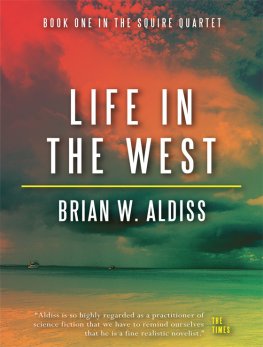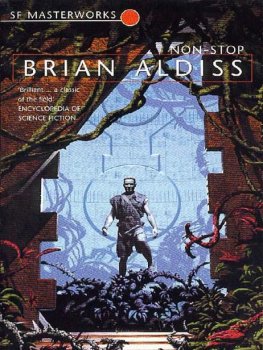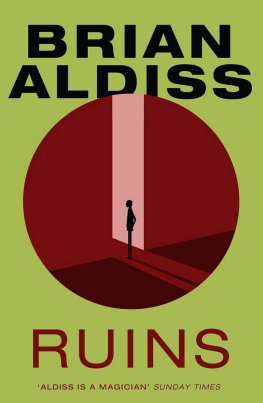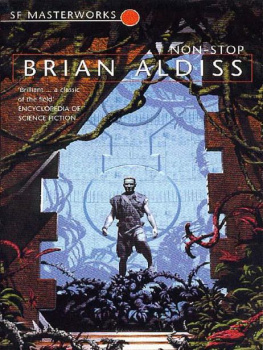Our ablest SF writer
Guardian
Propels the reader headlong into marvel. A trilogy which has acquired monumental nobility
The Times
Science fiction has never before had this grandeur
Times Literary Supplement
Brian Aldiss towering imagination places his Helliconia trilogy far above standard science fiction
Daily Mail
Rarely has someone elses brave new world been brought so stunningly to life
Daily Telegraph
One of the best SF writers Britain has ever produced
Iain M. Banks
A marvellous journey to another world a remarkable feat of the imagination
John Fowles
Also by Brian Aldiss
NOVELS
The Brightfount Diaries (1955)
Non-Stop (1958)
Bow Down to Nul (1960)
The Primal Urge (1961)
The Male Response (1961)
Hothouse (1962)
The Dark Light Years (1964)
Greybeard (1964)
Earthworks (1965)
An Age (1967)
Report on Probability A (1968)
Barefoot in the Head: A European Fantasia (1969)
The Hand-Reared Boy (1970)
A Soldier Erect (1971)
Frankenstein Unbound (1973)
The Eighty Minute Hour: A Space Opera (1974)
The Malacia Tapestry (1976)
Brothers of the Head (1977)
A Rude Awakening (1978)
Enemies of the System: A Tale of Homo Uniformis (1978)
Moreaus Other Island (1980)
Life in the West (1980)
Helliconia Spring (1982)
Helliconia Summer (1983)
Helliconia Winter (1985)
The Year Before Yesterday (1987)
Ruins (1987)
Forgotten Life (1988)
Dracula Unbound (1991)
Remembrance Day (1993)
Somewhere East of Life (1994)
White Mars Or, The Mind Set Free (with Roger Penrose) (1999)
Super-State (2002)
The Cretan Teat (2002)
Affairs at Hampden Ferrers (2004)
Sanity and the Lady (2005)
Jocasta (2006)
HARM (2007)
SHORT STORY COLLECTIONS
Space/ Time and Nathaniel (Presciences) (1957)
No Time Like Tomorrow (1959)
The Canopy of Time (1959)
Galaxies Like Grains of Sand (1960)
The Airs of Earth (1963)
Best Science Fiction Stories of Brian W. Aldiss (1965)
The Saliva Tree and Other Strange Growths (1966)
Intangible Inc. (1969)
The Moment of Eclipse (1970)
The Book of Brian Aldiss (1972)
Last Orders and Other Stories (1977)
New Arrivals, Old Encounters (1979)
Seasons in Flight (1984)
The Magic of the Past (1987)
Best SF Stories of Brian W. Aldiss (1988)
Science Fiction Blues (1988)
A Romance of the Equator: Best Fantasy Stories (1989)
A Tupelov Too Far (1994)
The Secret of This Book (1995)
Common Clay (1996)
Super-Toys Last All Summer Long and Other Stories of Future Time (2001)
Cultural Breaks (2005)
NON FICTION
The Shape of Further Things (1970)
Billion Year Spree (1973)
Science Fiction Art (1975)
Science Fiction Art (1976)
Science Fiction as Science Fiction (1978)
The World and Nearer Ones (1979)
The Pale Shadow of Science (1985)
And the Lurid Glare of the Comet (1986)
Trillion Year Spree (1986)
Bury My Heart at W.H. Smiths: A Writing Life (1990)
The Detached Retina (1995)
The Twinkling of an Eye or My Life as an Englishman (1998)
When the Feast is Finished (with Margaret Aldiss) (1999)
Art after Apogee: The Relationships between an Idea, a Story, a Painting (with Rosemary Phipps) (2000)
Helliconia
Helliconia Spring
Helliconia Summer
Helliconia Winter
BRIAN ALDISS
CONTENTS
INTRODUCTION
The premise of Helliconia can be set out in a sentence, but it takes hundreds of pages to understand fully what it means. The planet Helliconia is locked into an orbit around two stars that gives it a great year equivalent to 2,592 of ours. The three volumes making up the trilogy originally published as Helliconia Spring (1982), Helliconia Summer (1983), and Helliconia Winter (1985) chart this cycle. As the planet warms, the human-like inhabitants gain ascendancy over the savage phagors, but this pattern is reversed as the great year turns back to winter.
Helliconia is not the last science fiction work by Brian Aldiss he has had 25 years of productive writing since it was published but its easy to see it as a capstone for his work. It certainly embodies ideas he was working out in earlier books like Non-Stop (1958) and Hothouse (1962). They were concerned with how humanity discovers, or fails to discover, its place in a universe shaped by forces out of its control. In those books, knowledge of the true situation isnt especially consoling, but theres still great value attached to applying rationality to the world.
Helliconia marks something new in Aldiss work in the detail of its invention and the rigour with which the setting is presented. In a book like Hothouse, the flora and fauna of the garish future are described with a kind of joyous abandon. In Helliconia, theres still the same fascination with how the world works, but a more rigorous sense of how the ecosystem fits together. Aldiss acknowledges many scientists who helped him put together the picture of Helliconia: not least is James Lovelock, whose Gaia Hypothesis proposes that the elements of the Earths ecosystem interact far more intricately than we might think. Helliconias ecosystem is certainly elaborate, and the relationships within that system between humans and phagors, say are gradually revealed through the story.
In his history of SF, Billion Year Spree (1973), Aldiss talks at length about his admiration for writers of the scientific romance such as H. G. Wells and Olaf Stapledon. They too valued empirical investigation even as they warned about its limits and dangers. The scientific romance tends to use the viewpoint of a detached observer rather than a participant in the events described think of the traveller in The Time Machine or the disembodied narrator of Star Maker. Yet Aldiss has always been interested too in individual humans and their struggles. In Helliconia, the detached viewpoint is provided by the Earth space station Avernus, orbiting Helliconia and relaying its events back to our solar system. But what occupies the bulk of these books is the story of people like Yuli or Luterin and their efforts to fight for or preserve what seems most precious to them.
A couple of things can be picked out from this vast tapestry. The first, as I suggested above, is the idea of struggle. Helliconia is the very opposite of an abstract book because its so rooted in personal stories. Theres always the sense that whats most valuable about human society is potentially at risk and needs to be fought for. The second is self-knowledge. Its always significant in Aldiss work when someone knows, or becomes aware of, their place in the universe. So the dialogue between science and religion, as for instance between the king and CaraBansity in Chapter II of












